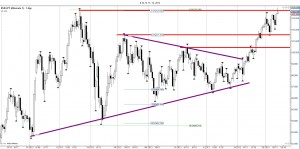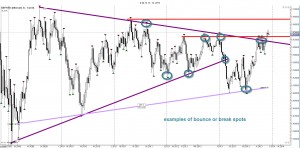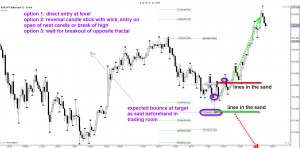Free eBook Download!Get A Simple 5-Step Momentum Trading Strategy
Hello Forex traders,
At one time, the USD/JPY was pushing through the yearly high, and the UJ bounce or break spot was mentioned in a previous article. Let’s take some time to use this as an example of the Bounce Trading Strategy in Forex and the role of support and resistance.

Before we begin, thanks for visiting Trading Strategy Guides (TSG)! We are so glad you’ve found us. You have discovered the most extensive library of trading content on the internet. Our aim is to provide the best educational content to traders of all stages. In other words, we want to make YOU a consistent and profitable trader.
If you’re a brand new trader, we recommend hopping over to our Ultimate Beginner’s Guide To Trading: What Is Trading?
This strategy hinges on the critical concept of support and resistance levels, which act as significant barriers in the currency markets. These levels, often determined by historical price points and psychological thresholds, play a pivotal role in shaping the trajectory of currency pairs such as USD/JPY.
Understanding the dynamics at these support and resistance zones is crucial for Forex traders. Bounce trading involves making strategic decisions based on the price action observed at these levels.
When a currency pair approaches a support or resistance zone, it can either break through these levels, indicating a strong market move or ‘bounce’ off them, signaling a potential reversal or retracement. Recognizing these patterns and responding aptly can be the key to successful trades in the volatile Forex market.
The Role of Support and Resistance
Support and resistance (S&R) are the key factors in the Forex market.

When the price reaches pre-determined support or resistance levels, the trader can then mark this zone as a “bounce or break spot” (more on that later on).
There are various ways Forex traders identify the support and resistance zone (testing the usefulness of their S&R identification is important).
Many elements could turn out to be support and resistance. Here is a list with a couple of examples:
- Tops and bottoms
- Trend lines
- Trend channels
- Fibonacci retracements
- Fibonacci targets and extensions
- Chart patterns
The support and resistance indicators could be used in various ways, such as:
- As a target, thereby placing a take profit at that level.
- As a filter, thereby purposely not taking a trade setup due to S&R.
- As a trigger and/or entry, thereby taking a potential trade upon the break or bounce.
Break or Bounce Spot
This article is geared towards explaining how a Forex trader can trade/approach a bounce or break spot (and is not focused on how the S&R is determined).

Once the Forex trader has identified this spot, then they have a “line in the sand.” They have a clear level which they mark for themselves as crucial.
Now, why is this important?
Well, the Forex trader needs to mark certain levels, areas, zones, and price zones as important in advance so that there is a clear moment when a decision is/has to be made, and all other price movement is filtered out (ignored).
If a Forex trader does not set up some kind of filter, then the process of trading would become very problematic, as all new data would be reviewed with the same importance (creating fear and greed).
Once a break or bounce spot has been identified (according to the trader’s tools), then they can wait for the price to reach that particular zone and wait for the price to either break or bounce off that particular support or resistance level.
**Note: A break is when the price pushes through the support and resistance. This is called a breakout trade, and the price then has enough momentum to break through that zone.
On the other hand, a bounce is when the price does not push through the support and resistance. In this case, the price does not have sufficient momentum to break, and the price then “respects” the zone.
In our trading room, we are on the lookout for breakout trade setups (strikes) and the first pullback after the breakout (boomerang) in the Forex market. This means:
- Strike = break trade.
- Boomerang = bounce trade.
Trading Bounces
A bounce scenario could mean that the price is either making a small retracement, a big retracement, or a reversal. In the case of a small retracement, the price might still break through the support and resistance a little bit later.
Big tops and bottoms and Fibonacci levels are usually not broken without at least some “respect” for these levels (price will not go through the level without stopping). The best way to find a Forex bounce trade is to use support and resistance levels.

A bounce trade can be entered via various methods, including:
Direct
A trader attempts to trade directly at the expected support or resistance zone.
- Example: Let’s say that you are looking at a particular Fibonacci level or top as a resistance. Having an entry order directly at that level is one way of trading an expected bounce at that S&R.
- Advantage: Earliest entry.
- Risk: Price continuing without stopping at the level.
- Problem: Stop-loss placement as the price can overextend on smaller time frames through the S&R area – even if it’s slight.
Confirmation of Bounce
A trader waits for a confirmation of the price to stop at the expected support or resistance zone.
- Example: Let’s say that you are looking at a particular Fibonacci level or top as a resistance. Waiting for a candlestick pattern at the expected S&R is a confirmation method.
- Advantage: Price is stopping at the expected level, and a clear stop loss level is known.
- Risk: Price could move away from S&R (substantially) before confirmation takes place.
- Problem: This could be a late entry, especially if the trade is taken against a prevailing trend.
Breakout after Bounce
This is very similar to Tim’s article on 123 reversals. One of the differences, I think, is the usage of Fractals (we’ll explain more in the section below). Also, read about Scaling in and Scaling out in Forex.
Bounce Using Fractals
Another way to trade the bounce trade is by using Fractals. Here is how the process would be:
- A Forex trader can anticipate a certain S&R to be important.
- Wait for the price to stop at or close to that level and make a Fractal.
- Wait for the price to move away from that S&R.
- Wait for the price to form a Fractal on the opposite side.
- Wait for a break of that opposite Fractal.
What does this mean?

Basically, by letting the price stop, reverse, stop, and reverse, the Forex trader now has 2 lines in the sand. One is at the expected S&R, and the other is on the opposite side. A break above or below either of these 2 levels then constitutes the likely winner.
For example:
There is an uptrend on the 4-hour chart. Price stops at the S&R (for instance, Fibonacci retracement). Price moves down 40 pips away from it and forms a Fractal on top of price on the 4-hour chart.
Price then bounces back up again with the trend but fails to break out above the resistance Fractal. At this point, there are 2 Fractals. A break above the Fractal constitutes a breakout, and a break below the Fractal means a “bounce breakout” (a breakout in the opposite direction after a bounce).
Via this method, a bounce trade is translated into a breakout. Each Forex trader can also use the BPC method as well: break, pullback, and continuation. The Fractal Indicator helps identify clear levels. Check out the article with more information on the Fractal here. Also, depending on the time frame, it is a good idea to go a few pips above or below a Fractal (6-20).
It is important to realize that the odds of success are greatest when trading the bounce either:
- During a very strong S&R and a trader is attempting to catch a strong reversal.
- When a trend and a trader is attempting to identify the S&R for trend continuation.
This is a Forex concept or method, not a system, which means there are no particular statistics. It would be the same as asking how successful breakouts are or trading with the trend.
The sample size is huge and depends on too many variables. Moreover, the idea could be a building block for a detailed trading strategy (read more here about creating Forex strategies). This Forex concept is a discretionary method of trading and must be used along with other tools and analysis, specifically multiple time frame analysis.
Final Thoughts about the Bounce Trading Strategy
The Bounce Trading Strategy in Forex, particularly when applied to pairs such as USD/JPY, provides a clear framework for understanding market movements around crucial support and resistance levels. These levels are not just arbitrary points but are significant zones where market psychology and historical data converge, influencing currency behavior.
By carefully analyzing how prices interact with these support and resistance zones, traders can make informed decisions, predicting whether the price will ‘bounce’ back or break through these levels.
Mastery of this strategy requires not only an understanding of these concepts but also an ability to adapt to the constantly changing dynamics of the Forex market. This ensures that traders are well-positioned to capitalize on potential opportunities presented by these critical junctures in price action.
Do you like Bounce Trading in Forex, or do you prefer breakouts? How do you trade bounces? Let us know in the comments below. Thanks!
Good luck trading, and thank you for reading!
Also, please give this strategy a 5 star if you enjoyed it!
Free eBook Download!Get A Simple 5-Step Momentum Trading Strategy



